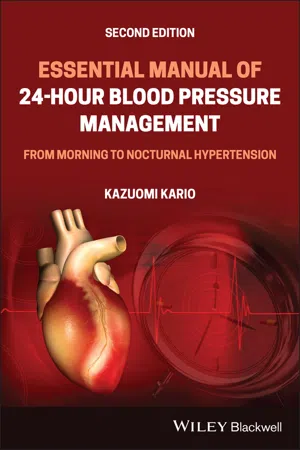
Essential Manual of 24-Hour Blood Pressure Management
From Morning to Nocturnal Hypertension
- English
- ePUB (mobile friendly)
- Available on iOS & Android
Essential Manual of 24-Hour Blood Pressure Management
From Morning to Nocturnal Hypertension
About This Book
ESSENTIAL MANUAL OF 24-HOUR BLOOD PRESSURE MANAGEMENT
Hypertension is one of the greatest threats to human health. The World Health Organization (WHO) estimates that 1.13 billion people worldwide have hypertension. In 2017, new guidelines for managing hypertension were published by the American Hypertension Association (AHA), guidelines which lowered the diagnosis thresholds of hypertension, and thereby increased the prevalence of hypertension. As such, hypertension is now recognized as a more serious and widespread a condition than ever before.
In this new edition of the Essential Manual of 24-Hour Blood Pressure Management, the author emphasizes that lowering the blood pressure (BP) and restoring the BP profile with adequate circadian rhythm is essential for a long life without cardiovascular events. The author also introduces updated evidence for managing hypertension throughout 24-hour periods, from morning to nocturnal hypertension.
The Essential Manual of 24-Hour Blood Pressure Management, Second Edition, will be an essential companion for doctors who wish to provide evidence-based medicine and be familiar with the most cutting edge technology on monitoring BP. Medical researchers and students will also value the author's many insights, drawn from his distinguished career.
Frequently asked questions
Information
CHAPTER 1
Evidence and scientific rationale for ambulatory blood pressure monitoring (ABPM)
Diurnal BP variation and the concept of “perfect 24‐hour BP control”


Nocturnal hypertension and nocturnal BP dipping status
Nocturnal BP dipping status
Table of contents
- Cover
- Table of Contents
- Title Page
- Copyright Page
- Author biography
- Preface – Direction to “Perfect 24‐hour Blood Pressure Control”
- Acknowledgments
- CHAPTER 1: Evidence and scientific rationale for ambulatory blood pressure monitoring (ABPM)
- CHAPTER 2: Scientific rationale for HBPM
- CHAPTER 3: Practical use of ABPM and HBPM
- CHAPTER 4: BP targets, when to initiate antihypertensive therapy, and nonpharmacological treatment
- CHAPTER 5: Antihypertensive medication
- CHAPTER 6: Renal denervation
- CHAPTER 7: Blood pressure linked telemedicine and telecare
- CHAPTER 8: Asia perspectives
- References
- Index
- End User License Agreement